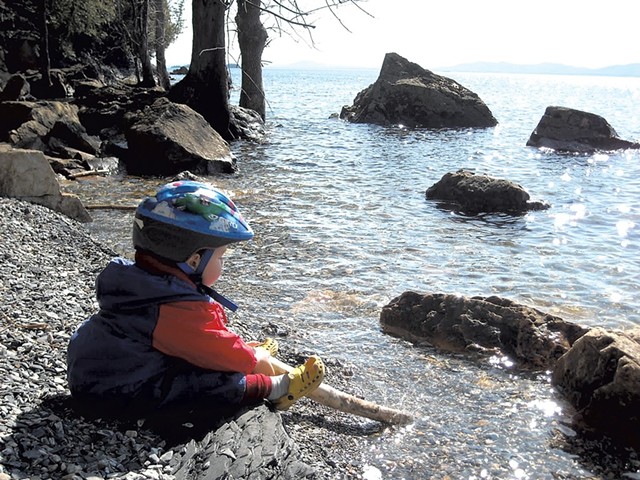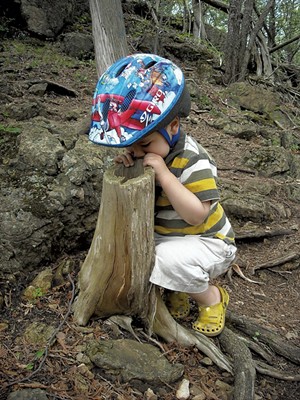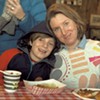Published March 3, 2020 at 10:00 a.m. | Updated April 6, 2022 at 9:21 a.m.
In my college marine biology class, I was amazed when the professor casually mentioned the forests and wetlands that used to line nearly the entire Atlantic seacoast. When I thought of the coast, I thought of the Jersey Shore, with houses as far as the eye could see.
After college, when I visited a beach that was part of a national park, I struggled to comprehend forest running all the way to the beach, but my mind went back to my professor's words and I realized, "This is what it must have looked like everywhere!"
It's not quite as hard to picture what Lake Champlain's coastline used to look like as it is New Jersey's. But — since humans do love to have their own little slice of the water — protected, public shoreline access is still a rare and special thing.
On Lake Champlain, undeveloped coastline often contains a rare natural community called Limestone Bluff Cedar-Pine Forest. This community grows on cliffs with extremely shallow soil over nutrient-rich bedrock. Northern white cedars thrive on these windswept bluffs.
In a similar community in Ontario, some of the cedars are nearly 1,000 years old. The oldest age I've heard about for any trees along Lake Champlain is around 300 years; most of our original cedars were logged. Still, whenever I walk here, I look at the twisted trunks and branches and remember that they are probably much more ancient than they look. Some species of trees, like cottonwoods, tend to put on thick rings every year and gain girth relatively quickly. But cedars growing out of rock may only put on a fraction of an inch a year.
Cedars also grow in a special way: Different sections of roots connect to specific sections of the trunk, so if a falling rock takes out one section of root or trunk, the rest is relatively unscathed.
When my son was small, I avoided the trails that ran along the cliffs when it was icy, but these bluffs with gnarled white cedars clinging to the rocky cliffs have spectacular views and are worth seeking out. Although I am quite taken with the cedars, these bluffs also are home to rare plants, unusual birds and bobcat dens.
Here are three great places where you can wander among them:
Rock Point, which together with the Arms Forest encompasses 160 acres that have just been conserved by the Lake Champlain Land Trust, is the "wild, green heart of Burlington," in the words of Alicia Daniel, the city's field naturalist. If you have been here before, you already know what a treasure it is. If you haven't, sign up for a free pass (though donations are accepted) at rockpointvt.org/visitor-passes. Rock Point is owned by the Episcopal Diocese of Vermont, and parking is available at the lot across from the diocesan building at 5 Rock Point Road; the road is the first right after Burlington High School. Look for the sign that says "Park here for trails." You can explore Rock Point for days and not see it all, but to find the cedars, look at the map on the web page where you get your pass and walk along either branch of the one-lane road towards the Holy Trinity and Sunset Ridge trails. (The northern part of the Holy Trinity Trail traverses a grove of hemlocks — also beautiful — but if you keep heading south you'll end up in the cedars.)
You may be familiar with the part of Kingsland Bay State Park in Ferrisburgh that houses the historic Hawley House and other buildings if you have attended an event there, but my favorite part of the 264 acres is a different spot. Park at the lot on Town Beach Road. You will first walk through an old pasture with many red cedars, growing today because the cows snacked on other species of plants and trees and let the red cedars grow. You'll soon come to the less-prickly white cedars and the shoreline.
There is also so much to see in the 584 acres of Niquette Bay State Park in Colchester. To find the gnarled cedars of the limestone bluff community, take the Burns Trail to Cedar Point. The trail runs about a mile over fairly flat terrain. Entry to the park is free before the first week in May.
One last tip: Something that can make the lingering snow of March more bearable is appreciating the way the snow makes the changes that are always happening more obvious for those of us with wimpy human senses. If you can go back to the same place two days in a row, you might be amazed by how different the snow conditions are — crisp one day, but mushy from a 10-degree rise in temperature the next, for example. You'll also be able to see signs left by overnight visitors — tracks, yes, but also, often, pee. Sometimes this can be quite dramatic!
It's a reminder that you are sharing the land with bobcats, foxes, coyotes and countless other organisms. Whether you're looking at the trees, the view or animal signs, these areas are oases in the developed landscape of Addison and Chittenden counties.
Heather Fitzgerald teaches field ecology and environmental science at the Community College of Vermont and the University of Vermont.
This article was originally published in Seven Days' monthly parenting magazine, Kids VT.
More By This Author
Speaking of...
-

Totally Transfixed: A Rare Eclipse on a Bluebird Day Dazzled Crowds in Northern Vermont
Apr 10, 2024 -

Vorsteveld Farm Held in Contempt Over Runoff
Jan 10, 2024 -

Q&A: Eva Sollberger Talks to Her Mother, Sophie Quest, About Aging
Oct 25, 2023 -

Video: Eva Sollberger Talks With Her Mom, Sophie Quest, About Aging
Oct 19, 2023 -

Plattsburgh Man Banned From Ferry for 'Disrespectful' Email
Sep 29, 2023 - More »
Comments
Comments are closed.
From 2014-2020, Seven Days allowed readers to comment on all stories posted on our website. While we've appreciated the suggestions and insights, right now Seven Days is prioritizing our core mission — producing high-quality, responsible local journalism — over moderating online debates between readers.
To criticize, correct or praise our reporting, please send us a letter to the editor or send us a tip. We’ll check it out and report the results.
Online comments may return when we have better tech tools for managing them. Thanks for reading.
















































